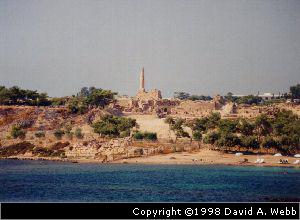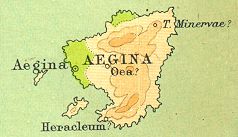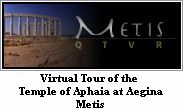

Aegina (New! Read W.M. Leake's account of Aegina: pre-1830 )
 Aegina Town
Aegina Town
The Modern Town of Aegina
Once a temporary capital of partially liberated Greece, today
Aegina (6,333 inhab.) is the main port on the island that dominates the Saronic
Gulf. It is only an hour's ride from Piraeus (about 20 km away), or
a half hour by Flying Dolphin. On my first trip over from Piraeus,
I actually saw some dolphins alongside the ship, a sign of good luck.
Approaching Aegina, Mt. Oros looms above the island. A sprawling population
has dotted the northern coastline with homes which stand out as you near
land. The lone remaining column from the archaic Temple of Apollo is
the next distinguishing landmark you will see as you round the northwestern
tip of the island. You eventually round a small promontory and the
modern town comes into view, stretching along a picturesque harbor.
The town is not very large and has many old buildings along the harbor, where
you can see fresh fruit and seafood brought in daily and sold right off the
boats. Aegina is famous around the world for its pistachio nuts, but it is
also well known for sponges and pottery. Over the course of about three
trips to the island, I have visited the remains at Colonna and the museum
twice, but neither time did I stay the night in Aegina. All the island's
transportation is centered in Aegina, at the plaza on the north side of town,
so you will have to go through there often if you are moving about the island.
Tip: Just north of Aegina Town, in the village of Livadi, a plaque
marks the house where Nikos Kazantzakis wrote the famous Zorba the Greek
.
Besides the numerous Neo-Classical mansions of the town, there are a couple of sites that you should not miss if you have made it this far. The first is the Venetian tower Pyrgos Markellou, located near the cathedral - a sight in itself - Agios Nikolaos. The Blue Guide has more information on the older buildings of the town. On the northern end of town, the archaeological museum has just recently been reopened after some big renovations, though it is still relatively small. The museum's collection includes some Neolithic and Bronze Age pottery as well as some other sculpture (note the sphinx). The museum sits at the entrance of the archaeological site, so we will proceed there next.
 The Ancient Town of Aegina
The Ancient Town of Aegina
In Classical times Aegina was called "the eyesore of gulf"
(by Aristotle) since it is very visible from the Acropolis and was an arch
rival for some time with Athens. Indeed the location of the island
was its greatest benefit. That is probably the same reason why as early
as the fourth millennium BCE, the island was inhabited. Mycenaeans
supplanted earlier settlements around 1400 BCE. Though it may have
been abandoned in the 11th and early 10th centuries BCE, it was recolonized
by Epidauros and by the mid seventh century, it became the first in Europe
to mint coins. The modern town of Aegina sits above some of the ancient
town, which was the largest settlement on the island. Its naval forces
controlled most of the trade between mainland Greece and the rest of the
Aegean, and although it had earlier sided with Persia, in 480 BCE, the Aeginetans
outperformed all other Greeks at Salamis. In 456 however, the Aeginetans
were defeated by the Athenians whose envy they had drawn. Most inhabitants
left for Thyrea under Spartan protection, but some returned in 404.
In one of his odes for victorious athletes (Olympian 8),
Pindar praised a youth from Aegina:
Timosthenes,
fortune has allotted you and your brother to
the care of your ancestor Zeus, who made you renowned at
Nemea, and made Alcimedon an Olympic victor beside the hill of
Cronus. He was beautiful to look at, and his deeds did not belie
his beauty [20] when by his victory in wrestling he had Aegina
with her long oars proclaimed as his fatherland. There the savior
Themis, seated beside Zeus the god of hospitality, is honored
more than among all other men. For when there is a heavy
weight in the balance that sways many ways, to judge with a
straight mind and not inopportunely [25] is a difficult struggle.(
trans. Perseus
)
Today the ancient site is called Colonna, due to the single remaining column that towers above the remains. As mentioned earlier, you may enter the remains through the gate at the archaeological museum. The Austrian Institute has been working at the site for some time, cleaning and surveying the site. There have been numerous remains of Early-Late Helladic structures found here, and these are some of the most visible from the the platform at the column. The column itself was once part of a Temple of Apollo that was once thought to belong to Aphrodite. It is thought that the temple was built around 520-500 BCE, but some scholars are hesitant to accept this date. It definitely was of the Doric order, and the columns were obviously monolithic. There were six columns on the ends and 12 on the sides. A late Roman fortress was built atop the temple and parts still remain towards the sea. Unfortunately during the construction of the harbor by Capodistrias, much of the conglomerate blocks from the structure were used to create a modern mole (which sits atop the ancient one). Tip: You can see the ancient foundations underwater if you take a look at an aerial view of the town (try a postcard).
...The ceremonies for Nektarios go
on all night, from about 5:00 P.M. the previous day,
all-night vigils being a mark of spiritual
merit here. People have already gotten up at dawn
to kiss the saint's tomb, and the bus
on the way to the church has standing room only. I
wedge in, just behind the driver.
The passengers cross themselves, elaborating the cross
three times as they pass the town cemetery.
The men wear sprigs of basil in their
buttonholes, a common sight on Greek
Orthodox feast days. The monastery is built on one
of those hills whose overhang makes
the roads of island Greece so narrow. A small homely
taverna faces it-the site asks for
a building that will live within the folds of this land that looks
like dough kneaded by a god, while the
walls should be of some earth color that will not argue
with the lion-colored landscape.
Instead, the furious and distinctively retroactive Greek
ambition came into play, and the architect
apparently attempted to copy Istanbul's Saint
Sofia; Agios Nektarios is still unfinished,
but the driver tells me that it is nevertheless the
largest church in Greece.
![Temple of Minerva in Aegina, formerly called Jupiter Panhellenius [sic] by Copley Fielding in Wordsworth, C. Greece: Pictorial, Descriptive, Historical. London 1882](aegina1.jpg) Temple of Aphaia
Temple of Aphaia  The temple's pedimental sculpture is quite confusing and very famous.
There exists three different sets (possibly four!) of pedimental sculpture,
two for the east end. One was probably either a damaged or rejected
set or was just replaced for some other reason. The extremely fine late
archaic pedimental sculptures were made of Parian marble. Seventeen
statues were found in 1811 and were taken to Munich. Having been taken
away by the original British and German excavators, the sculptures were sold
to Ludwig I of Bavaria and are now in the Glyptothek in Munich. They
were partially restored by Thorvaldsen in Rome before being sent on to Munich.
Check the link below to see images of the sculptures.
The temple's pedimental sculpture is quite confusing and very famous.
There exists three different sets (possibly four!) of pedimental sculpture,
two for the east end. One was probably either a damaged or rejected
set or was just replaced for some other reason. The extremely fine late
archaic pedimental sculptures were made of Parian marble. Seventeen
statues were found in 1811 and were taken to Munich. Having been taken
away by the original British and German excavators, the sculptures were sold
to Ludwig I of Bavaria and are now in the Glyptothek in Munich. They
were partially restored by Thorvaldsen in Rome before being sent on to Munich.
Check the link below to see images of the sculptures.
The temple has been struck by lightning in the past 30 years (so there is a big rod next to the temple) but the damage was not too extensive. The view is amazing, though the pine trees are growing ever taller. You can see the Parthenon and the temple at Sounion from here if you bring some good binoculars. There is also a terrific view back all along the mainland. Pausanias (2.30.3) described the site without going into much architectural detail.
In Aegina, as you go towards the mountain of Zeus, God of all the Greeks,
you reach a sanctuary of Aphaea, in whose honor Pindar composed an ode
for the Aeginetans. The Cretans say (the story of Aphaea is Cretan) that
Carmanor, who purified Apollo after he had killed Pytho, was the father of
Lubulus, and that the daughter of Zeus and of Carme, the daughter of Eubulus,
was Britomartis. She took delight, they say, in running and in the chase,
and
was very dear to Artemis. Fleeing from Minos, who had fallen in love with
her,
she threw herself into nets which had been cast (aphemena) for a draught of
fishes. She was made a goddess by Artemis, and she is worshipped, not only
by the Cretans, but also by the Aeginetans, who say that Britomartis shows
herself in their island. Her surname among the Aeginetans is Aphaea; in Crete
it is Dictynna (Goddess of Nets). (
trans. Perseus
)
To the summit: from here you must take a steep path up the north side of Mt. Oros. Almost at the summit was a settlement of Bronze Age peoples. But the settlement was destroyed along with most of the other Mycenaean sites in Greece around the beginning of the eleventh century. The top of Oros gives a view of the Saronic Gulf that is breathtaking. There is supposedly a temple and an altar on the peak, but my information was not clear on the point.
Moni is actually another island, but I will include it with Aegina since it is so close and uninhabited. A deserted island where there was once attempted a resort (the remains are prominent and derelict), Moni is now a wildlife sanctuary, though I do not know if this is official or just de facto. Tourists are allowed to visit during the day (take a small boat from Perdhika) and there are usually sunbathers and artists painting. There is also a German W.W.II lookout post at the top of the large hill. Good for a day hike, though I tired out as the tree line stopped and did not make it to the top. The island is inhabited by numerous peacocks and miniature horses with wild goats and giant hares (I know that sounds terribly odd). The peacocks and horses can be a pest though. The remains of the previous resort developments are an eyesore and junk is laying around all over the island. The beaches are not very large also, but it is still peaceful and unique.
Modern Sources
Berve, Helmut and Gottfried Gruben,
Greek Temples, Theaters, and Shrines, Harry
N. Abrams,
Inc., New York) (p. 74, 347-351 **, plates 42-45)
Bulfinch, Thomas, The Age of Fable,
Henry Altemus, Philadelphia, 1899 (Origin of the
Myrmidons,
p. 116)
Dinsmoor, William Bell, The Architecture
of Ancient Greece, Biblo and Tannen, New
York, 1973
(p. 39, 41, 71, 105-107 *, 165, 170, 338 and foldout)
Furtwangler, Adolf, Aegina: Das
Heiligtum der Aphaia, Verlag der K. B. Akademie der
Wissenschaften,
Munchen, Germany, 1906 (in German; has good pictures and
drawings
though)
Furtwangler, Adolf and H. L. Urlichs,
Greek and Roman Scultpure (translated by
Horace Taylor),
E. P. Dutton & Company, New York, (plates III-IV *, figures 3-5)
Lullies, Reinhard, Greek Sculpture,
Harry N. Abrams, Inc., New York, 1960 (plates
72-77, 82-87)
Ohly, Dieter, Die Aeginetan, Band
I, Die Ost Giebelgruppe, Verlag C. H. Beck,
Munchen,
Germany, 1976 (everything ***, pictures of everything on the east
pediment
from every possible angle, reconstructions of east pediment from up,
down, and
back)
Ohly, Dieter, The Munich Glyptothek
(English Edition), C. H. Beck, Nordlingen,
Germany,
1974 (p. 47-66 *)
Richter, Gisela M. A., A Handbook
of Greek Art, Praeger Publishers, Inc., New York,
1974 (p.
31, 32, 92-93, illustration 20, figures 112-113)
Richter, Gisela M. A., Three Critical
Periods in Greek Sculpture, Oxford Univerisity
Press, London,
1951 (p. 5)
Richter, Gisela M. A., The Sculpture
and Sculptors of the Greeks, Yale University
Press, New
Haven, 1970 (p. 7, 40, 42, 43, 50, 97, 122, 124, 127, 133, 252;
illustrations:
108, 120, 121, 1994, 415, 416, 564)
Ridgway, Brunilde Sismondo, The
Archaic Style in Greek Sculpture, Princeton
University
Press, Princeton, 1977 (p. 210, 212, and 215)
Ridgway, Brunilde Sismondo, Fifth
Century Styles in Greek Sculpture, Princeton
University
Press, Princeton, 1981 (p. 26, brief reference on Herakles the Archer)
Ridgway, Brunilde Sismondo, The
Severe Style in Greek Sculpture, Princeton
University
Press, Princeton, 1970 (p. 13-17 *, 89)